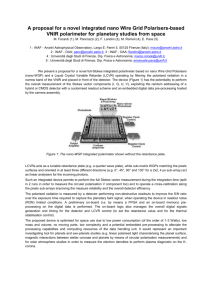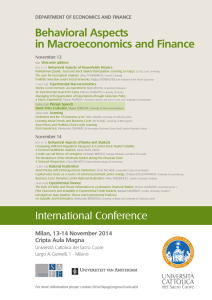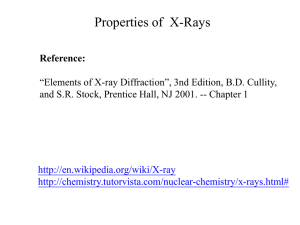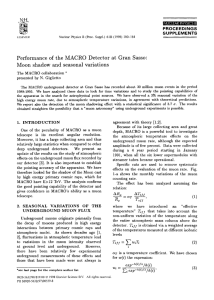Experimental setup for muon diagnostics of the Earth`s atmosphere
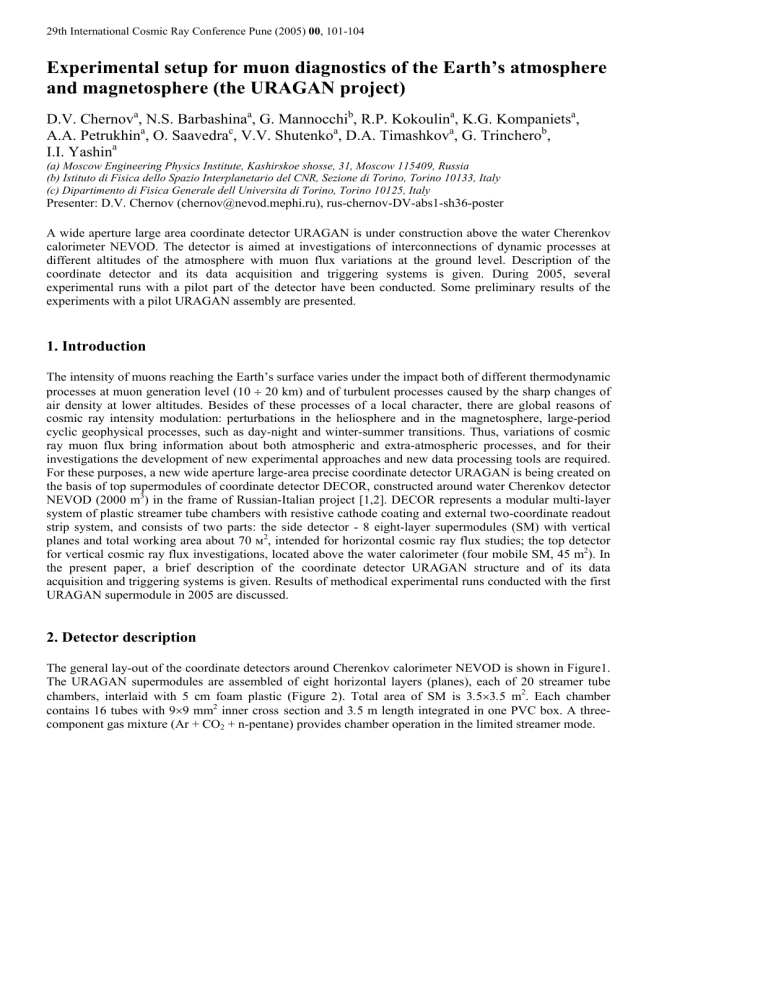
29th International Cosmic Ray Conference Pune (2005) 00 , 101-104
Experimental setup for muon diagnostics of the Earth’s atmosphere and magnetosphere (the URAGAN project)
D.V. Chernov a , N.S. Barbashina
A.A. Petrukhin a , O. Saavedra c a , G. Mannocchi
, V.V. Shutenko a b , R.P. Kokoulin a
, D.A. Timashkov a
, K.G. Kompaniets a
, G. Trinchero
I.I. Yashin a
(a) Moscow Engineering Physics Institute, Kashirskoe shosse, 31, Moscow 115409, Russia b ,
,
(b) Istituto di Fisica dello Spazio Interplanetario del CNR, Sezione di Torino, Torino 10133, Italy
(c) Dipartimento di Fisica Generale dell Universita di Torino, Torino 10125, Italy
Presenter: D.V. Chernov (chernov@nevod.mephi.ru), rus-chernov-DV-abs1-sh36-poster
A wide aperture large area coordinate detector URAGAN is under construction above the water Cherenkov calorimeter NEVOD. The detector is aimed at investigations of interconnections of dynamic processes at different altitudes of the atmosphere with muon flux variations at the ground level. Description of the coordinate detector and its data acquisition and triggering systems is given. During 2005, several experimental runs with a pilot part of the detector have been conducted. Some preliminary results of the experiments with a pilot URAGAN assembly are presented.
1. Introduction
The intensity of muons reaching the Earth’s surface varies under the impact both of different thermodynamic processes at muon generation level (10 ÷ 20 km) and of turbulent processes caused by the sharp changes of air density at lower altitudes. Besides of these processes of a local character, there are global reasons of cosmic ray intensity modulation: perturbations in the heliosphere and in the magnetosphere, large-period cyclic geophysical processes, such as day-night and winter-summer transitions. Thus, variations of cosmic ray muon flux bring information about both atmospheric and extra-atmospheric processes, and for their investigations the development of new experimental approaches and new data processing tools are required.
For these purposes, a new wide aperture large-area precise coordinate detector URAGAN is being created on the basis of top supermodules of coordinate detector DECOR, constructed around water Cherenkov detector
NEVOD (2000 m 3 ) in the frame of Russian-Italian project [1,2]. DECOR represents a modular multi-layer system of plastic streamer tube chambers with resistive cathode coating and external two-coordinate readout strip system, and consists of two parts: the side detector - 8 eight-layer supermodules (SM) with vertical planes and total working area about 70 м 2 , intended for horizontal cosmic ray flux studies; the top detector for vertical cosmic ray flux investigations, located above the water calorimeter (four mobile SM, 45 m 2 ). In the present paper, a brief description of the coordinate detector URAGAN structure and of its data acquisition and triggering systems is given. Results of methodical experimental runs conducted with the first
URAGAN supermodule in 2005 are discussed.
2. Detector description
The general lay-out of the coordinate detectors around Cherenkov calorimeter NEVOD is shown in Figure1.
The URAGAN supermodules are assembled of eight horizontal layers (planes), each of 20 streamer tube chambers, interlaid with 5 cm foam plastic (Figure 2). Total area of SM is 3 .
5 × 3 .
5 m 2 . Each chamber contains 16 tubes with 9 × 9 mm 2 inner cross component gas mixture (Ar + CO
2 section and 3 .
5 m length integrated in one PVC box. A three-
+ n-pentane) provides chamber operation in the limited streamer mode.
102 D.V. Chernov et al.
Every layer of streamer tube chambers is equipped with two-coordinate external strip readout system
(320X + 288Y channels with 1.0 cm and 1.2 cm pitch, respectively). The setup provides particle detection in a wide range of zenith angles (from 0 to 80 ° ) with spatial and angular accuracy about 1 cm and 1 ° , correspondingly. For continuous monitoring of the atmosphere, a new readout electronics with possibility of the detection and on-line reconstruction of every muon was developed and manufactured. Pairs of neighboring supermodules are served by local stations which include low-voltage and high-voltage supply and gas distribution posts. Every SM is equipped with a computer of the data acquisition system (DAQ).
In 2005, the first URAGAN supermodule was assembled, and experimental runs for tests of all hardware and software system operation capability were conducted.
Figure 1.
Experimental complex NEVOD. Figure 2. The URAGAN mobile supermodule.
3. Data acquisition system
The data-acquisition and triggering systems of the coordinate detector URAGAN have a distributed architecture. As a front-end electronics of data acquisition, specialised fast readout electronic cards were designed. Each card provides detection, discrimination, storage in shift registers and subsequent readout of signals from 16 registration channels (strips). One detector plane is served by 20 X-coordinate and 18 Ycoordinate cards. Each card has two data readout channels. The first channel is formed by D-triggers of card control circuits and provides information about the triggered cards. The second one is formed by shift registers and allows to receive information about the triggered strips. The control circuit includes the shift registers into the second readout channel only in the case of appearance of triggered strips in a given card.
Accordingly, the data are read only from the triggered cards. It provides a necessary data readout and data processing speed. Data readout is performed synchronically by the clock pulse from two channels by means of SPI compatible interface.
The cards are mounted along the two sides of every detector layer on X- and Y-strips of external readout system. For one supermodule, 160 X-cards and 144 Y-cards are necessary, and 8 cross-cards (one for every detector plane) are used for the connecting pipeline and low voltage supply cable matching. The module time resolution is determined mainly by jitter associated with the drift of electrons inside the tubes to anode wires (about 100 ns), and with the spread of propagation time of logical signals inside the modules (up to 50
Experimental setup for muon … 103 ns). Respectively, typical pulse duration used for various coincidences in the trigger system is 0.2 - 0.3 µ s.
The requirement of the first level trigger formation is the coincidence of at least four signals OR from different planes within 300 ns, that with 96 % efficiency identifies a particle crossing the SM. The trigger is formed on the basis of signals from the supermodule X-cards.
At triggering of four X-cards in different planes (single muon detection, 95% of events), the supermodule data readout time is about 30 s. Such readout speed, taking into account single muon trigger efficiency, allows to detect every muon with 93% efficiency. Information on every event is read and processed in DMA mode.
The detection and triggering system provides the following operation regimes:
1. The measurement of counting rate of all eight detector planes.
2. Checkout of sequences of shift registers and card D-trigger sequences.
3. Operation in exposition regime.
The response of URAGAN supermodule represents two arrays with information about two projections (XOZ and YOX) of triggered strips for every event (mostly single muons). The track parameters (two projection angles) are “on-line” reconstructed by means of software program, based on the technique of histogramming of hits in each projection plane, and are accumulated in two-dimensional array ( θ x
, θ y
) during one minute interval. Such matrix represents the “muon image” of the upper hemisphere within the limits of detector acceptance with 1 minute exposition. In Figure3, a single muon event detected by URAGAN SM is shown.
The results of data processing (one minute matrices, containing about 6 × 10 hard disc, or transmitted to the local computer net, together with additional monitoring information. The storaged data represent the sequence of one minute arrays. One data run contains up to 7200 one minute matrices.
4 events) are either written to
Figure 3. URAGAN supermodule response at single muon passing through detector.
An example of one minute two-dimensional matrix is shown in Figure4.
Figure 4. One minute matrix of stored experimental data.
104 D.V. Chernov et al.
4. Experimental Run 2005
In 2005, methodical experimental runs on cosmic ray muon registration by the pilot supermodule of the
URAGAN coordinate detector were conducted. The main tasks of these runs were:
1.
tests and adjustment of readout electronics operation in conditions of real experiment;
2.
development and tests of the supermodule triggering system, check of its efficiency, reliability and stability;
3.
tests and improvements of URAGAN software environment.
During the experimental series from 24 March till 1 June 2005, the data of 18 runs, containing 96173 one minute matrices, were storaged and analyzed. The average counting rate of the pilot setup was about 1.3 kHz. The total counting rate during one month of the exposition is shown in Figure5. For the comparison, the dependence of atmospheric pressure is plotted, too.
The accumulated experimental material is used for further optimisation of trigger selection conditions and for elaboration of the program of long-term physical measurements with the help of the URAGAN detector.
Figure 5. Total counting rate of URAGAN supermodule.
5. Conslusion
The first part of wide-aperture coordinate detector URAGAN with high spatial (~ 1 cm) and angular (~ 1 ° ) resolution intended for investigations of interrelations of various processes in the atmosphere, Earth's magnetosphere and heliosphere with muon flux variations has been designed and constructed. Triggering and data acquisition systems provide the detection of the full muon flux from any direction of the upper hemisphere ( θ < 80 ° ). Methodical experimental runs conducted in Spring 2005 have demonstrated the reliability of operation of all systems of the coordinate detector. At present, the second part of the coordinate detector is being assembled above the sensitive volume of the water calorimeter NEVOD.
6. Acknowledgements
The work is supported by Department of Science of Government of Moscow, Moscow Committee of
Science and Technology and Federal Agency for Science and Innovations of the Russian Federation.
References
[1] M.B. Amelchakov et al., Proc. 27th ICRC, Hamburg, 3, 1267 (2001).
[2] I.I. Yashin et al., Proc. 28th ICRC, Tsukuba, 3, 1147 (2003).
